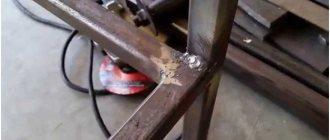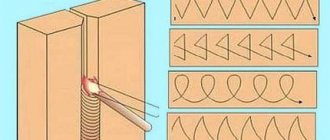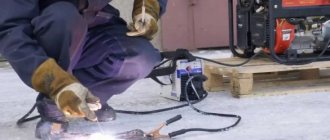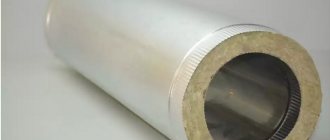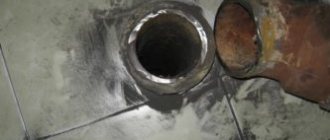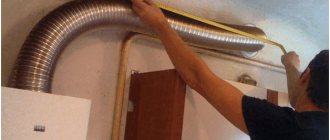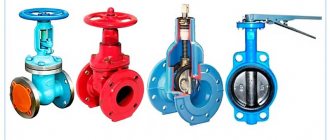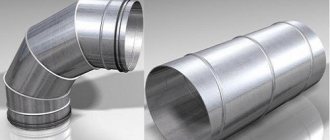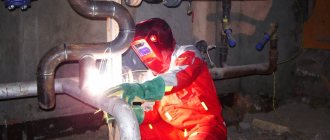A thin zinc coating increases the corrosion resistance of steel. Galvanized steel is often used in welded metal structures. In order for them to be durable, it is necessary to take into account the difference in the melting temperature of zinc and carbon alloys. Since destruction of the protective layer is unacceptable, when welding galvanized steel it is necessary to observe technological features that preserve the integrity of the zinc coating.
Welding of galvanized steel is carried out using several methods: using electrodes and filler wire. It will be useful for beginners to learn how to make a high-quality connection without damaging the protective coating. Experienced welders share their knowledge of the nuances of the welding process.
Features of zinc coating
Anti-corrosion coating is applied to steel using several methods. Depending on the technology, the coating thickness of galvanized sheets ranges from two to 150 microns. It is easy to burn through, zinc melts at a temperature of +906°C, steel - at +1100°C. With the usual method of welding metal, the coating will inevitably suffer. It must be coated with a protective flux, which prevents the surface from heating up.
Another difficulty in galvanizing welding is the high toxicity of the vapors emitted by the protective coating. Welding zinc requires respiratory protection. The coating first softens, then goes into a gaseous state. These vapors, when inhaled, cause severe intoxication. If it is necessary to install galvanizing, you need to use masks with forced air injection or work in a well-ventilated area equipped with ventilation.
Liquid zinc significantly reduces the quality of the weld. Makes it loose and fragile. To prevent it from getting into the metal heating zone, the areas in the seam area are cleaned. Removing the zinc coating is a mandatory procedure for joining galvanized steel. Basic surface cleaning methods:
- Hot, when the edges of the workpiece are burned with a gas torch before welding. A quick but unsafe method; it produces too many toxic fumes.
- Chemical method, processing parts with acid or alkali. After this, the surfaces must be washed and dried.
- The mechanical, protective layer is cleaned off with a steel brush, sandpaper, or other abrasive material.
When cleaning the surface, the rest of the coating is not touched; corrosion quickly forms in places of damage.
Important tips for welding work
Any welding is considered a complex technological process that requires compliance with a number of important requirements. Welding galvanized steel is complicated by the fact that you additionally have to work with a protective zinc coating. The main feature of this process is that galvanization begins to melt at a temperature of 420 degrees, and at 906 degrees it boils and evaporates.
All these processes have a negative impact on the quality of the welded joint; cracks, pores, and various defects begin to form in it. To prevent this from happening, welding of galvanized steel must be carried out at other temperatures, and there must also be a special protected gas environment.
For effective welding, galvanized steel welding wire and copper are commonly used. Wires made of aluminum-bronze and copper-silicon alloy are considered the most suitable. If filler wire is used, galvanized welding will be correct.
This method has a number of positive qualities:
- during the working process there is no corrosion damage to the weld;
- there is a minimal degree of splashing;
- slight fading of the zinc coating;
- low level of heat input;
- soldering of steel is subsequently accompanied by simple processing;
- Cathodic protection of the material is observed.
During the welding process, zinc passes into a special weld pool, and this causes cracks, damage, and pores to appear in the joint. For this reason, before starting work, the zinc layer must be removed.
Removal is usually carried out with a gas torch, an abrasive wheel, and brushes. There are also chemical methods for removing zinc, which use alkalis. After treatment, the area is washed with water and dried well.
Selecting Electrodes
When electric arc welding is used when installing galvanized metal structures, conventional electrodes for steel are not suitable. How is galvanizing done? You need consumables (electrodes or wire for semi-automatic machines) with rutile coating. For low-carbon alloys, electrodes of the following types are purchased:
- ANO-4, designed for welding galvanized sheets with direct and alternating current;
- MP-3, require an open circuit voltage of at least 50 V;
- OZS-4, analogs of welding wire SV08A, SV08. Grades with a high flux content: UONI-13/45, UONI-13/55, DSK-50. They are used for all types of galvanizing, including welding high-carbon alloys, when high quality welds are required. Contains carbonates and fluoride compounds. They can cook galvanized steel of any thickness. For thick metal, several passes must be made.
MP-3 electrodes require an open circuit voltage of at least 50 V
Point method
Galvanization with Al, Mn, Si additives (so-called TRIP steels) is widely used in the automotive industry. Materials can be successfully welded when resistance spot welding is performed correctly.
When carrying out serial operations, in accordance with reference indicators, the shape and dimensions of the electrodes are selected, taking into account the thickness of the galvanized material.
The resulting connection point is characterized by strength, which is higher than that of the original sheets. When checking a seam for rupture, the rupture line does not pass through the welding point, but nearby.
Inverter-type welding machines operate on direct or alternating current. A method that provides good results requires a lot of energy.
Contact equipment that supplies three types of pulses is popular: for preheating the working area, directly welding galvanized steel, and subsequent heat treatment.
When spot welding any materials, including galvanized steel, the electrodes noticeably wear out. Therefore, at stationary welding stations there is an automatic possibility of adjusting modes and adjusting the process as a whole.
It is almost impossible to do this using manual technology. During one cycle, changing the size and shape of the seam is unacceptable. Spot welding in industrial flows is carried out using modern, fully automated equipment.
Methods of welding galvanized metal
Gas and electric arc welding can be used to connect galvanized sheets. Point detection is possible; this method is applicable in enterprises. For spot welding of galvanized steel, special machines are needed. In a garage, galvanized arc welding is more often used using protective fluxes, special electrodes or wire, less often semi-automatic, it is used in auto repair shops, in production, and requires expensive equipment. Each method of welding galvanized metal structures has its own advantages. Getting to know the advantages and disadvantages of each will help you decide on the choice of device. How and how to weld galvanize depends on the experience of the welder. Using traditional galvanizing welders requires skill. Beginners will find it difficult to maintain the amperage. It is difficult to avoid lack of penetration or burns. An inverter or semi-automatic is preferable in this regard.
How to weld pipes
The approaches to installation and repair of pipelines made of metal alloys with zinc coating are the same as when working with other products.
Fluxes can be used. First, the pipes to be welded must be thoroughly cleaned outside and inside, then heated. If the diameter does not exceed 3 mm, the edges do not need to be specially processed.
For pipes with a large diameter, the edges are opened by 90 degrees and blunted by 1.5 mm. The gap width during welding in both cases is 2-3 mm. Softened flux is applied to the galvanized surface in double the amount used for uncoated steel pipes.
If the pipe diameter does not exceed 250 mm and the metal thickness is 6 mm, choose nozzles with a size of up to 2 mm. To weld wider pipes made of thick metal, nozzles with sizes from 2 mm to 4 mm are needed.
Good quality at high speed of execution is ensured by electric arc welding of any zinc-coated pipes. A highly qualified welder, the correct choice of electrodes, and optimal process speed will ensure the quality of the galvanized connection. To prevent oxidation processes after work is completed, the welding site and adjacent areas must be treated with special compounds.
Welding galvanized parts is not such a rare process at any welding enterprise. Galvanizing is a layer of zinc that is used to coat various types of steel. Zinc has many advantages; galvanized parts have good performance characteristics, are less susceptible to corrosion and generally last longer. At the same time, galvanizing can be used both in the manufacture of complex metal structures and in the production of household products.
But you need to understand that zinc has a number of its own characteristic features that complicate welding. In addition, in modern production, very high demands are placed on welders in terms of the quality of work and the amount of defects. And if in one case a professional welding machine for galvanized metal will help you out, then in another case mistakes will be inevitable. In this article we will briefly describe how to cook galvanized steel not only quickly, but also efficiently.
Semi-automatic welding
A high-quality seam is obtained in an atmosphere of carbon dioxide or argon. When welding galvanized metal with a semi-automatic machine, gas is supplied along with the filler or electrode wire along the sleeve. The additive parameters depend on the thickness of galvanization:
| Galvanization thickness | The diameter of the wire |
| Up to 4 mm | 0.6 - 0.8 mm |
| 4 mm | 0.8 - 1 mm |
| Over 4 mm | 1 - 1.2 mm |
Disadvantages of using a semi-automatic machine:
- you can’t use it in the wind; problems arise when powerful ventilation is running;
- it is necessary to purchase large gas cylinders;
- you need rigid shielding gas supply hoses (sleeves).
Advantages of semi-automatic galvanizing welding:
- work without a protective atmosphere is permissible;
- the evenness of the seam is guaranteed;
- it is easier to maintain current parameters.
There are a number of features of working with a semi-automatic machine:
- thin metal is spot welded to prevent burns;
- at voltages below 220 V, the filler wire size is reduced by 0.2 mm;
- for the method without the use of shielding gas, an electrode filler wire is selected;
- the terminal with the positive contact clings to the workpiece, the negative one is connected to the additive.
Semi-automatic galvanizing welding
Consumables
As you understand, it is consumables that play the most important role when welding galvanized parts. No matter how professional your welding machine is, you simply will not be able to make the right seam if you select the wrong consumables. Next we will talk about filler wire and electrodes, which simplify the process of welding zinc products.
When choosing wire, make sure that it has a low melting point. Typically, such wire contains a lot of copper. We recommend filler wire with a melting point of 900 to 1100 degrees Celsius. When working with such wire, the filler material itself will melt, but the steel will not. This approach is more similar to soldering than welding, but believe me, the connection will be very strong.
The most popular wire for welding galvanized parts is CuSi3. The seam obtained with its help is not the strongest, but it is then convenient to work with and subject to mechanical processing. Due to the silicon in the composition, such wire begins to spread when melted, so keep an eye on what alloying substances are in the composition of this filler material.
CuAl8 and CuSi2Mn wires are also often used. CuSi2Mn forms a very strong weld (provided it contains manganese), but is then very difficult to machine. Processing takes much more effort and time. CuAl8 is used in welding metals that are coated with zinc and aluminum.
We recommend using a short arc during the soldering process. This way it will burn much more stable. If you use a long arc, it will be unstable due to zinc fumes. This problem is especially difficult to solve when welding parts with a thick layer of zinc.
Make sure that the metal does not splash. To do this, you can cook using a method that uses a short current pulse. Well, shielding gas will further simplify the welding process.
Welding zinc also requires proper setup of the welding equipment. We recommend setting the amperage to low to help keep the length and stability of the welding arc under control. With a small current, the metal will not overheat, and along with it, zinc will not evaporate in large quantities. You will already get better quality just by setting the amperage to low.
If you are cooking semi-automatically, then select the “Synergic” mode. Not all welders have this setting, but don’t neglect it if your semi-automatic machine is capable of working in this mode. With its help, you can automatically adjust many welding parameters, which means improving the quality of the seam.
The essence of this mode is extremely simple: the manufacturer selects optimal settings for different types of filler materials at the factory and arranges them into so-called presets (a set of settings that can be selected by pressing one button). You only need to select one preset, and the device will select the rest of the settings itself. This way you will simplify and optimize your work, you will spend more time on forming a seam than on setting up the welder, and this is very important.
If you still decide to use an inverter and electrodes for galvanized steel, then you can use rods designed for welding low-carbon and low-alloy steels. Such electrodes often have a rutile coating, which is a big plus. Based on our experience, you can safely purchase electrodes of the ANO-4, MR-3, OZS-4, UONI-13/45, UONI-13/55, DSK-50 brands. You can easily find them in most specialty stores. They are inexpensive and at the same time provide satisfactory quality of the welded joint.
Welding with inverter
An inverter is needed when working with thin galvanized steel, less than 2 mm. Welding of galvanized parts is carried out with a current of reverse polarity; a negative contact is attached to the workpiece. The electrode holder must be connected to the positive. With this connection, the electrode heats up quickly; a couple of seconds are enough for ignition.
With the help of inverters, even beginners can weld galvanized steel efficiently. The electrode does not fade and moves smoothly along the connection. A strong seam without defects is formed.
Useful tips
Experts are advised to pay special attention to some points:
- After cleaning the joint with a steel brush, restoration of the zinc coating with special protective compounds is required. They come in aerosol packages and small containers. They are used to process the seam and the connection point of the terminal (crocodile clip).
- At the joints, the current is increased to 15 amperes, and the speed of the electrode is reduced; a dense bead should be formed that can withstand the dynamic bending load.
- A short arc allows you to control the quality of the seam, and there is less spattering of the bathtub metal. The likelihood of sparks burning through the zinc coating is reduced.
- The equipment is configured for low-current modes. On semi-automatic devices the “Synergic” mode is set, on inverters – 5-10 amperes below the table values.
- Beginners should not forget to check the quality of the seam. After removing the slag, it is visually inspected and gently tapped, this makes it easier to identify the defect.
